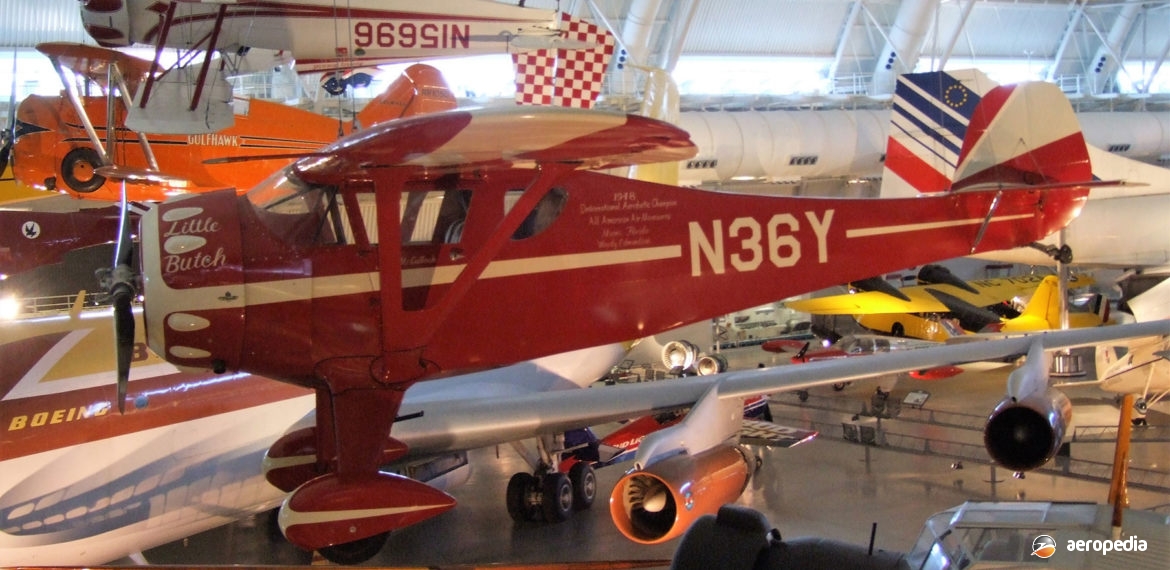Photograph:
Mono Aircraft Monocoupe 110 Special Little Butch N36Y at the Udvar Hazy Museum in Washington, USA in July 2007 (David C Eyre)
Country of origin:
United States of America
Description:
Two-seat light cabin monoplane
Power Plant:
One 41 kw (55 hp) Velie five-cylinder air-cooled radial engine
Specifications:
- Wingspan: 9.75 m (32 ft)
- Length: 6.06 m (19 ft 9 in)
- Height: 1.92 m (6 ft 3 in)
- Wing area: 13.28 m² (143 sq ft)
- Max speed: 158 km/h (98 mph)
- Max cruising speed: 137 km/h (95 mph)
- Cruising speed: 137 km/h (85 mph)
- Landing speed: 60 km/h (37 mph)
- Rate of climb at sea level: 168 m/min (550 ft/min)
- Service ceiling: 3,200 m (10,500 ft)
- Range: 805 km (500 miles)
- Fuel capacity: 95 litres (21 Imp gals)
- Empty weight: 361 kg (795 lb)
- Useful load: 252 kg (555 lb)
- Payload weight: 98 kg (215 lb)
- Loaded weight: 612 kg (1,350 lb)
History:
The Monocoupe was originally designed by Don Luscombe but evolved through a number of models by the efforts of Luscombe and Clayton Folkerts. It was built in large numbers from 1928 to the late 1950s with a variety of engines. Production also took place at the Central States Aero Co of Davenport, Iowa, this Company later becoming the Monocoupe Aircraft Corp of Moline, Illinois, and later the Monocoupe Corp of Robertson, Missouri. It was a subsidiary of Allied Aviation Industries.
The first Monocoupe was built in an abandoned church and flew for the first time on 1 April 1927. Engines fitted at that time included the 45 kw (60 hp) Anzani five-cylinder radial, the British-built Cirrus, and the German Siemens-Halske. The model 70 was placed in production with the 41 kw (55 hp) Velie engine, this unit being manufactured by Mono Aircraft. Some 350 examples with this engine were sold during 1928 and 1929. Mr W L Velie was president of Mono Aircraft.
The Monocoupe was described as an easy to fly aircraft and advertisements stated it was designed for the novice as well as the professional pilot. After the Series 70 came the Series 113 of 1929, and the Series 90 of 1930 which was longer, was wider, had a redesigned undercarriage, and was fitted with the 67 kw (90 hp) Lambert R-266 five-cylinder radial. The Series 110 introduced the 93 kw (125 hp) Warner Scarab seven-cylinder radial; and later the 90J appeared with the 67 kw (90 hp) Warner Scarab Junior five-cylinder radial.
Later models were produced with other engines, including the Kinner five-cylinder radial, the Warner Scarab, and a Franklin unit. Construction was welded steel tube fuselage faired to shape and fabric covered. The wing framework was of solid spruce spars, spruce and basswood built up ribs, and fabric covered. Fuel was carried in two tanks, one in each wing.
During 1928 the Monocoupe 70 was the highest selling light aircraft in the United States. Production at some stage was transferred to a Melbourne, Florida facility but was shelved in 1941 so the facility could be turned to production of equipment for the American military and did not resume until after the war. After World War II it became a division of Universal Moulded Products. Development continued until production ceased in the 1950s.
One example was imported to this region. This aircraft, a Model 113, was imported to New Zealand by Mr O Cottrell in January 1929 and became ZK-ABD (c/n 113 – ex NC7006). After assembly, it was test flown by George Bolt. It was fitted with a Velie M-5 engine and painted in a colour scheme of black fuselage with an orange wing. It was wrecked in a crash near Gear Island in April 1930 and written off. It was subsequently rebuilt by Mr Cottrell with assistance of Mr L Maughan using parts of another fuselage which had been fire damaged, and using the wings and undercarriage from ZK-ABD. It regularly was thereafter seen flying from beaches in the Manawatu and Horowhenua areas. However, a broken crankshaft and lack of spare parts for the engine caused it to be stored at Milson in the old Union Airways hangar and it was here it was destroyed by fire in October 1943.
In early 1999 Aviat Inc in the United States announced it intended to put into production modernised versions of the Globe Swift and the Monocoupe 110 Special. A small number of restored Monocoupes appear on the US Civil Register, and others are preserved in museums.

